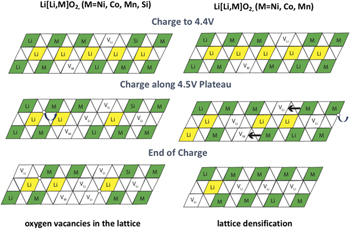Crossref Citations
This article has been cited by the following publications. This list is generated based on data provided by
Crossref.
Zhang, Wen
Han, Tianli
Cheng, Mengying
Zhang, Min
Zhong, Yan
Cheng, Dong
Zhou, Ping
and
Liu, Jinyun
2019.
High-performance ternary nickel-cobalt-manganese oxide nanoparticles-anchored reduced graphene oxide composite as Li-ion battery cathode: Simple preparation and comparative study.
Ceramics International,
Vol. 45,
Issue. 16,
p.
20105.
Zong, Fengyi
Xie, Tingzhen
Lin, Xiaoping
Xue, Dongyang
Shen, Yidong
and
Li, Qiuhong
2020.
Flower-like hierarchical Li1.2Ni0.13Co0.13Mn0.54O2 by architectural design for lithium-ion batteries with superior capacity retention.
Ceramics International,
Vol. 46,
Issue. 17,
p.
27010.
Jin, Yi
Hu, Chen
Chen, Cheng
Sun, Dandan
Du, Chunyu
Jian, Jiyuan
and
Yin, Geping
2020.
Study on the Effect of the Pre-treatment Temperature on Li1.2Mn0.54Ni0.13Co0.13O2 Cathode Material.
International Journal of Electrochemical Science,
Vol. 15,
Issue. 11,
p.
11356.
Nation, Leah
Wu, Yan
Liu, Xiaoming
Chi, Miaofang
Wu, Yuqin
Qi, Yue
and
Sheldon, Brian W.
2021.
Redox-couple investigations in Si-doped Li-rich cathode materials.
Physical Chemistry Chemical Physics,
Vol. 23,
Issue. 4,
p.
2780.
Liu, Junxiang
Wang, Jiaqi
Ni, Youxuan
Zhang, Kai
Cheng, Fangyi
and
Chen, Jun
2021.
Recent breakthroughs and perspectives of high-energy layered oxide cathode materials for lithium ion batteries.
Materials Today,
Vol. 43,
Issue. ,
p.
132.
L, Prettencia
E, Soundarrajan
AM, Shanmugharaj
RA, Kalaivani
and
S, Raghu
2022.
Combustion-assisted synthesis of Mn-rich cathode for high performance Li-ion batteries.
Journal of Energy Storage,
Vol. 48,
Issue. ,
p.
104054.
Wang, Hongyu
Zhan, Feng
Zhan, Haiqing
and
Ming, Xianquan
2022.
Improve the Midpoint Voltage and Structural Stability of Li-Rich Manganese-Based Cathode Material by Increasing the Nickel Content.
Catalysts,
Vol. 12,
Issue. 6,
p.
584.
Chang, Longjiao
Yang, Wei
Cai, Kedi
Bi, Xiaolong
Wei, Anlu
Yang, Ruifen
and
Liu, Jianan
2023.
A review on nickel-rich nickel–cobalt–manganese ternary cathode materials LiNi0.6Co0.2Mn0.2O2 for lithium-ion batteries: performance enhancement by modification.
Materials Horizons,
Vol. 10,
Issue. 11,
p.
4776.
Ko, Gyeongbin
Jeong, Seongdeock
Park, Sanghyuk
Lee, Jimin
Kim, Seoa
Shin, Youngjun
Kim, Wooseok
and
Kwon, Kyungjung
2023.
Doping strategies for enhancing the performance of lithium nickel manganese cobalt oxide cathode materials in lithium-ion batteries.
Energy Storage Materials,
Vol. 60,
Issue. ,
p.
102840.
Woodley, Christopher P.
Cooper, Rachel A.
and
Bartlett, Bart M.
2024.
Cu Doping Increases Capacity Retention in LiNi0.6Mn0.2Co0.2O2 (NMC622) by Altering the Potential of the Ni-Based Redox Couple and Inhibiting Particle Pulverization.
ACS Applied Energy Materials,
Vol. 7,
Issue. 18,
p.
7875.
Latif, Hamid
Sabah, Noor Us
Sattar, Abdul
Öktem, Ahmet Sinan
Uyanık, Mehmet Sinan
Topaç, Erdal
Anjum, Dalaver H.
Wang, YuHuang
Arshad, Muhammad
and
Alam, M. Mansoor
2025.
Enhanced performance of lithium-ion battery cathodes using a composite conductive network of CNTs, GQDs, and GNRs embedded in Li₁.₂Mn₀.₅₄Ni₀.₁₃Co₀.₁₃O₂ (LMNCO).
Journal of Energy Storage,
Vol. 106,
Issue. ,
p.
114823.
Kumari, Prachi
and
Kundu, Rajen
2025.
Outlook of Doping Engineering in NMC and LMNO Cathode Materials for Next-Generation Li-Ion Batteries.
Energy & Fuels,
Vol. 39,
Issue. 23,
p.
10933.
